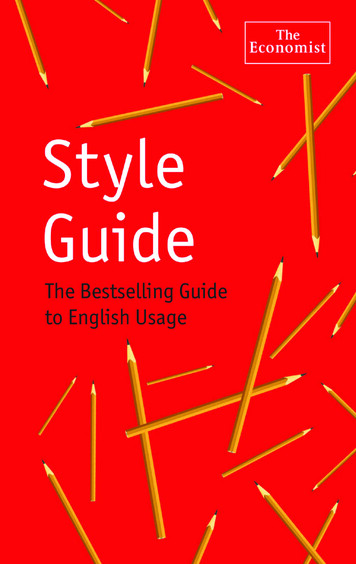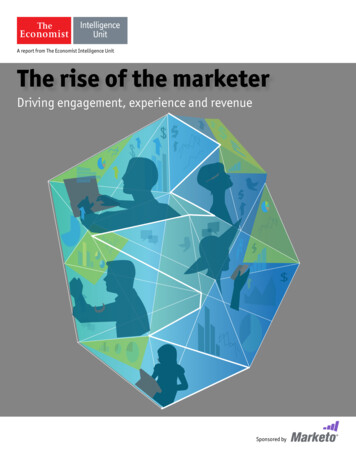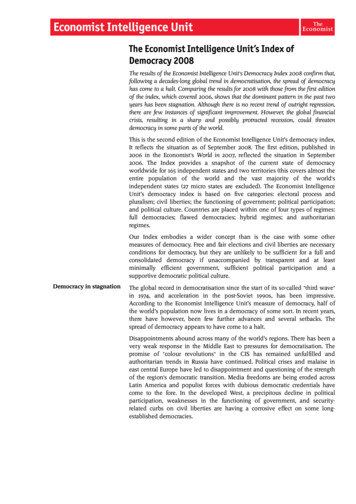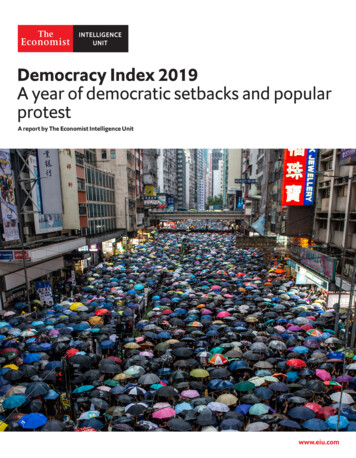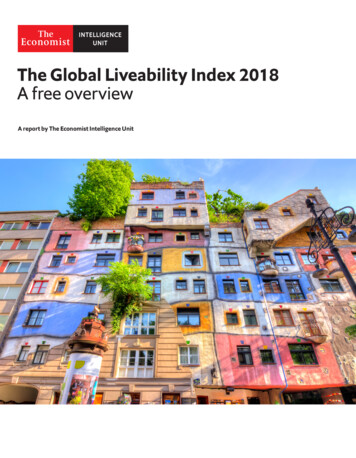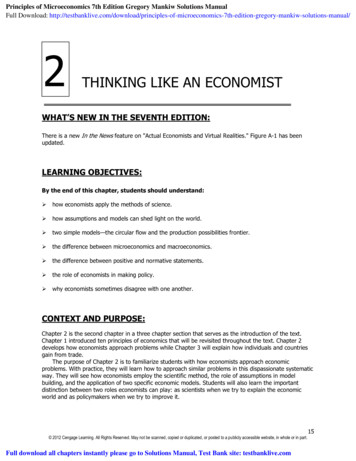
Transcription
Principles of Microeconomics 7th Edition Gregory Mankiw Solutions ManualFull Download: anual/w2THINKING LIKE AN ECONOMISTWHAT’S NEW IN THE SEVENTH EDITION:There is a new In the News feature on "Actual Economists and Virtual Realities." Figure A-1 has beenupdated.LEARNING OBJECTIVES:By the end of this chapter, students should understand: how economists apply the methods of science. how assumptions and models can shed light on the world. two simple models—the circular flow and the production possibilities frontier. the difference between microeconomics and macroeconomics. the difference between positive and normative statements. the role of economists in making policy. why economists sometimes disagree with one another.CONTEXT AND PURPOSE:Chapter 2 is the second chapter in a three chapter section that serves as the introduction of the text.Chapter 1 introduced ten principles of economics that will be revisited throughout the text. Chapter 2develops how economists approach problems while Chapter 3 will explain how individuals and countriesgain from trade.The purpose of Chapter 2 is to familiarize students with how economists approach economicproblems. With practice, they will learn how to approach similar problems in this dispassionate systematicway. They will see how economists employ the scientific method, the role of assumptions in modelbuilding, and the application of two specific economic models. Students will also learn the importantdistinction between two roles economists can play: as scientists when we try to explain the economicworld and as policymakers when we try to improve it. 2012 Cengage Learning. All Rights Reserved. May not be scanned, copied or duplicated, or posted to a publicly accessible website, in whole or in part.Full download all chapters instantly please go to Solutions Manual, Test Bank site: testbanklive.com15
16 Chapter 2/Thinking Like an EconomistKEY POINTS: Economists try to address their subject with a scientist’s objectivity. Like all scientists, they makeappropriate assumptions and build simplified models to understand the world around them. Twosimple economic models are the circular-flow diagram and the production possibilities frontier. The field of economics is divided into two subfields: microeconomics and macroeconomics.Microeconomists study decision making by households and firms and the interaction amonghouseholds and firms in the marketplace. Macroeconomists study the forces and trends that affectthe economy as a whole. A positive statement is an assertion about how the world is. A normative statement is an assertionabout how the world ought to be. When economists make normative statements, they are actingmore as policy advisers than as scientists. Economists who advise policymakers sometimes offer conflicting advice either because of differencesin scientific judgments or because of differences in values. At other times, economists are united inthe advice they offer, but policymakers may choose to ignore the advice because of the many forcesand constraints imposed by the political process.CHAPTER OUTLINE:I.The Economist as ScientistA. Economists Follow the Scientific Method.1. Observations help us to develop theory.2. Data can be collected and analyzed to evaluate theories.3. Using data to evaluate theories is more difficult in economics than in physical sciencebecause economists are unable to generate their own data and must make do with whateverdata are available.4. Thus, economists pay close attention to the natural experiments offered by history.B. Assumptions Make the World Easier to Understand.1. Example: to understand international trade, it may be helpful to start out assuming thatthere are only two countries in the world producing only two goods. Once we understandhow trade would work between these two countries, we can extend our analysis to a greaternumber of countries and goods.2. One important role of a scientist is to understand which assumptions one should make.3. Economists often use assumptions that are somewhat unrealistic but will have small effectson the actual outcome of the answer.C. Economists Use Economic Models to Explain the World around Us. 2012 Cengage Learning. All Rights Reserved. May not be scanned, copied or duplicated, or posted to a publicly accessible website, in whole or in part.
Chapter 2/Thinking Like an Economist 17To illustrate to the class how simple but unrealistic models can be useful, bring aroad map to class. Point out how unrealistic it is. For example, it does not showwhere all of the stop signs, gas stations, or restaurants are located. It assumes thatthe earth is flat and two-dimensional. But, despite these simplifications, a mapusually helps travelers get from one place to another. Thus, it is a good model.1. Most economic models are composed of diagrams and equations.2. The goal of a model is to simplify reality in order to increase our understanding. This iswhere the use of assumptions is helpful.D. Our First Model: The Circular Flow DiagramFigure 11. Definition of circular-flow diagram: a visual model of the economy that shows howdollars flow through markets among households and firms. 2012 Cengage Learning. All Rights Reserved. May not be scanned, copied or duplicated, or posted to a publicly accessible website, in whole or in part.
18 Chapter 2/Thinking Like an Economist2. This diagram is a very simple model of the economy. Note that it ignores the roles ofgovernment and international trade.a. There are two decision makers in the model: households and firms.b. There are two markets: the market for goods and services and the market for factors ofproduction.c.Firms are sellers in the market for goods and services and buyers in the market forfactors of production.d. Households are buyers in the market for goods and services and sellers in the market forfactors of production.e. The inner loop represents the flows of inputs and outputs between households and firms.f.The outer loop represents the flows of dollars between households and firms.E. Our Second Model: The Production Possibilities Frontier1. Definition of production possibilities frontier: a graph that shows the combinationsof output that the economy can possibly produce given the available factors ofproduction and the available production technology.Spend more time with this model than you think is necessary. Be aware that themath and graphing skills of many of your students will be limited. It is important forthe students to feel confident with this first graphical and mathematical model. Bedeliberate with every point. If you lose them with this model, they may be gone forthe rest of the course.2. Example: an economy that produces two goods, cars and computers.a. If all resources are devoted to producing cars, the economy would produce 1,000 carsand zero computers.b. If all resources are devoted to producing computers, the economy would produce 3,000computers and zero cars.c.More likely, the resources will be divided between the two industries, producing somecars and some computers. The feasible combinations of output are shown on theproduction possibilities frontier. 2012 Cengage Learning. All Rights Reserved. May not be scanned, copied or duplicated, or posted to a publicly accessible website, in whole or in part.
Chapter 2/Thinking Like an Economist 19Figure 2You may want to include time dimensions for variables. This will help students torealize that a new production possibilities frontier occurs for each period. Thus, theaxes show the levels of output per period.ALTERNATIVE CLASSROOM EXAMPLE:A small country produces two goods: mp3 players and music downloads. Points on aproduction possibilities frontier can be shown in a table or a graph:mp3 PlayersMusic 00The production possibilities frontier should be drawn from the numbers above.Students should be asked to calculate the opportunity cost of increasing the number of mp3players produced by 100: between 0 and 100 between 100 and 200 between 200 and 300 between 300 and 400Points inside the curve, points on the curve, and points outside of the curve can also bediscussed. 2012 Cengage Learning. All Rights Reserved. May not be scanned, copied or duplicated, or posted to a publicly accessible website, in whole or in part.
20 Chapter 2/Thinking Like an Economist3. Because resources are scarce, not every combination of computers and cars is possible.Production at a point outside of the curve (such as C) is not possible given the economy’scurrent level of resources and technology.It is useful to point out that the production possibilities frontier depends on twothings: the availability of resources and the level of technology.4. Production is efficient at points on the curve (such as A and B). This implies that theeconomy is getting all it can from the scarce resources it has available. There is no way toproduce more of one good without producing less of another.5. Production at a point inside the curve (such as D) is inefficient.a. This means that the economy is producing less than it can from the resources it hasavailable.b. If the source of the inefficiency is eliminated, the economy can increase its production ofboth goods.6. The production possibilities frontier reveals Principle #1: People face trade-offs.a. Suppose the economy is currently producing 600 cars and 2,200 computers.b. To increase the production of cars to 700, the production of computers must fall to2,000.7. Principle #2 is also shown on the production possibilities frontier: The cost of something iswhat you give up to get it (opportunity cost).a. The opportunity cost of increasing the production of cars from 600 to 700 is 200computers.b. Thus, the opportunity cost of each car is two computers.8. The opportunity cost of a car depends on the number of cars and computers currentlyproduced by the economy.a. The opportunity cost of a car is high when the economy is producing many cars and fewcomputers.b. The opportunity cost of a car is low when the economy is producing few cars and manycomputers.9. Economists generally believe that production possibilities frontiers often have this bowed-outshape because some resources are better suited to the production of cars than computers(and vice versa). 2012 Cengage Learning. All Rights Reserved. May not be scanned, copied or duplicated, or posted to a publicly accessible website, in whole or in part.
Chapter 2/Thinking Like an Economist 21Be aware that students often have trouble understanding why opportunity costs riseas the production of a good increases. You may want to use several specificexamples of resources that are more suited to producing cars than computers(e.g., an experienced mechanic) as well as examples of resources that are moresuited to producing computers than cars (e.g., an experienced computerprogrammer).10. The production possibilities frontier can shift if resource availability or technology changes.Economic growth can be illustrated by an outward shift of the production possibilitiesfrontier.Figure 3You may also want to teach students about budget constraints at this time (call them“consumption possibilities frontiers”). This reinforces the idea of opportunity cost,and allows them to see how opportunity cost can be measured by the slope. Also, itwill introduce students to the use of straight-line production possibilities frontiers(which appear in Chapter 3). However, be careful if you choose to do this as studentsoften find the difference between straight-line and concave production possibilitiesfrontiers challenging.ALTERNATIVE CLASSROOM EXAMPLE:Ivan receives an allowance from his parents of 20 each week. He spends his entireallowance on two goods: ice cream cones (which cost 2 each) and tickets to the movies(which cost 10 each).Students should be asked to calculate the opportunity cost of one movie and the opportunitycost of one ice cream cone.Ivan’s consumption possibilities frontier (budget constraint) can be drawn. It should be notedthat the slope is equal to the opportunity cost and is constant because the opportunity cost isconstant.Ask students what would happen to the consumption possibilities frontier if Ivan’s allowancechanges or if the price of ice cream cones or movies changes.F. Microeconomics and Macroeconomics1. Economics is studied on various levels.a. Definition of microeconomics: the study of how households and firms makedecisions and how they interact in markets.b. Definition of macroeconomics: the study of economy-wide phenomena,including inflation, unemployment, and economic growth.2. Microeconomics and macroeconomics are closely intertwined because changes in the overalleconomy arise from the decisions of individual households and firms. 2012 Cengage Learning. All Rights Reserved. May not be scanned, copied or duplicated, or posted to a publicly accessible website, in whole or in part.
22 Chapter 2/Thinking Like an Economist3. Because microeconomics and macroeconomics address different questions, each field has itsown set of models which are often taught in separate courses.II. The Economist as Policy AdviserA. Positive versus Normative Analysis1. Example of a discussion of minimum-wage laws: Polly says, “Minimum-wage laws causeunemployment.” Norma says, “The government should raise the minimum wage.”2. Definition of positive statements: claims that attempt to describe the world as it is.3. Definition of normative statements: claims that attempt to prescribe how the worldshould be.4. Positive statements can be evaluated by examining data, while normative statements involvepersonal viewpoints.5. Positive views about how the world works affect normative views about which policies aredesirable.Use several examples to illustrate the differences between positive and normativestatements and stimulate classroom discussion. Possible examples include theminimum wage, budget deficits, tobacco taxes, legalization of marijuana, and seatbelt laws.Have students bring in newspaper articles and in groups, identify each statement inan editorial paragraph as being a positive or normative statement. Discuss thedifferences among news stories, editorials, and blogs and the analogy to economistsas scientists and as policy advisers.6. Much of economics is positive; it tries to explain how the economy works. But those who useeconomics often have goals that are normative. They want to understand how to improvethe economy.B. Economists in Washington1. Economists are aware that trade-offs are involved in most policy decisions.2. The president receives advice from the Council of Economic Advisers (created in 1946).3. Economists are also employed by administrative departments within the various federalagencies such as the Office of Management and Budget, the Department of Treasury, theDepartment of Labor, the Congressional Budget Office, and the Federal Reserve.4. The research and writings of economists can also indirectly affect public policy.C. Why Economists’ Advice Is Not Always Followed 2012 Cengage Learning. All Rights Reserved. May not be scanned, copied or duplicated, or posted to a publicly accessible website, in whole or in part.
Chapter 2/Thinking Like an Economist 231. The process by which economic policy is made differs from the idealized policy processassumed in textbooks.2. Economists offer crucial input into the policy process, but their advice is only part of theadvice received by policymakers.III. Why Economists DisagreeA. Differences in Scientific Judgments1. Economists may disagree about the validity of alternative positive theories or about the sizeof the effects of changes in the economy on the behavior of households and firms.2. Example: some economists feel that a change in the tax code that would eliminate a tax onincome and create a tax on consumption would increase saving in this country. However,other economists feel that the change in the tax system would have little effect on savingbehavior and therefore do not support the change.B. Differences in ValuesC. Perception versus Reality1. While it seems as if economists do not agree on much, this is in fact not true. Table 1contains 20 propositions that are endorsed by a majority of economists.Table 1Emphasize that there is more agreement among economists than most people think.The reason for this is probably that the things that are generally agreed upon areboring to most noneconomists.2. Almost all economists believe that rent control adversely affects the availability and quality ofhousing.3. Most economists also oppose barriers to trade.IV. In the News: Actual Economists and Virtual RealitiesA. Professional Economists have begun working in the video game industry as consultants todevelopers and to experiment with policy options.B. This is an article from the Washington Post describing the involvement of economists in the videogame industry.V. Appendix—Graphing: A Brief ReviewMany instructors may be unaware of how much trouble beginning students havegrasping the most basic graphs. It is important for instructors to make sure thatstudents are comfortable with these techniques. 2012 Cengage Learning. All Rights Reserved. May not be scanned, copied or duplicated, or posted to a publicly accessible website, in whole or in part.
24 Chapter 2/Thinking Like an EconomistWhen reviewing graphing with the students, it is best to bring students to the boardto be “recorders” of what the other students say as you give a series of instructionslike “Draw a pie chart” or ask questions like “How tall should the bar be if the value is120 million?” Do not make the student at the board responsible for the answer.Instead he should be simply recording what the other students say. Students areoften uneasy about graphing at first and need to gain confidence.A. Graphs of a Single VariableFigure A-11. Pie Chart2. Bar Graph3. Time-Series GraphB. Graphs of Two Variables: The Coordinate SystemFigure A-21. Economists are often concerned with relationships between two or more variables.2. Ordered pairs of numbers can be graphed on a two-dimensional grid.a. The first number in the ordered pair is the x-coordinate and tells us the horizontallocation of the point.b. The second number in the ordered pair is the y-coordinate and tells us the verticallocation of the point.3. The point with both an x-coordinate and y-coordinate of zero is called the origin.4. Two variables that increase or decrease together have a positive correlation.5. Two variables that move in opposite directions (one increases when the other decreases)have a negative correlation.C. Curves in the Coordinate System1. Often, economists want to show how one variable affects another, holding all other variablesconstant.Table A-1Figure A-3 2012 Cengage Learning. All Rights Reserved. May not be scanned, copied or duplicated, or posted to a publicly accessible website, in whole or in part.
Chapter 2/Thinking Like an Economist 25a. An example of this is a demand curve.b. The demand curve shows how the quantity of a good a consumer wants to purchasevaries as its price varies, holding everything else (such as income) constant.c.If income does change, this will alter the amount of a good that the consumer wants topurchase at any given price. Thus, the relationship between price and quantity desiredhas changed and must be represented as a new demand curve.Figure A-4d. A simple way to tell if it is necessary to shift the curve is to look at the axes. When avariable that is not named on either axis changes, the curve shifts.D. SlopeFigure A-51. We may want to ask how strongly a consumer reacts if the price of a product changes.a. If the demand curve is very steep, the quantity desired does not change much inresponse to a change in price.b. If the demand curve is very flat, the quantity desired changes a great deal when theprice changes.2. The slope of a line is the ratio of the vertical distance covered to the horizontal distancecovered as we move along the line (“rise over run”).slope y x3. A small slope (in absolute value) means that the demand curve is relatively flat; a large slope(in absolute value) means that the demand curve is relatively steep.E. Cause and Effect1. Economists often make statements suggesting that a change in Variable A causes a changein Variable B.2. Ideally, we would like to see how changes in Variable A affect Variable B, holding all othervariables constant.3. This is not always possible and could lead to a problem caused by omitted variables.Figure A-6a. If Variables A and B both change at the same time, we may conclude that the change inVariable A caused the change in Variable B. 2012 Cengage Learning. All Rights Reserved. May not be scanned, copied or duplicated, or posted to a publicly accessible website, in whole or in part.
26 Chapter 2/Thinking Like an Economistb. But, if Variable C has also changed, it is entirely possible that Variable C is responsible forthe change in Variable B.4. Another problem is reverse causality.Figure A-7a. If Variable A and Variable B both change at the same time, we may believe that thechange in Variable A led to the change in Variable B.b. However, it is entirely possible that the change in Variable B led to the change in VariableA.c.It is not always as simple as determining which variable changed first because individualsoften change their behavior in response to a change in their expectations about thefuture. This means that Variable A may change before Variable B but only because of theexpected change in Variable B.There are two very good examples in the text that you should use in class. Todiscuss the omitted variable problem, point out to students that a rise in the sales ofcigarette lighters is positively related to the number of individuals diagnosed withlung cancer. To discuss reverse causality, show that an increase in minivan sales isfollowed by an increase in birth rates.SOLUTIONS TO TEXT PROBLEMS:Quick Quizzes1. Economics is like a science because economists devise theories, collect data, and analyze the data inan attempt to verify or refute their theories. In other words, economics is based on the scientificmethod.Figure 1 shows the production possibilities frontier for a society that produces food and clothing.Point A is an efficient point (on the frontier), point B is an inefficient point (inside the frontier), andpoint C is an infeasible point (outside the frontier). 2012 Cengage Learning. All Rights Reserved. May not be scanned, copied or duplicated, or posted to a publicly accessible website, in whole or in part.
Chapter 2/Thinking Like an Economist 27Figure 1The effects of a drought are shown in Figure 2. The drought reduces the amount of food that can beproduced, shifting the production possibilities frontier inward. (If a drought also reduced the amountof cotton available for the production of clothing, the intercept on the vertical axis would alsodecrease.)Figure 2Microeconomics is the study of how households and firms make decisions and how they interact inmarkets. Macroeconomics is the study of economy-wide phenomena, including inflation,unemployment, and economic growth.2. An example of a positive statement is “a higher price of coffee causes me to buy more tea.” It is apositive statement because it is a claim that describes the world as it is. An example of a normativestatement is “the government should restrain coffee prices.” It is a normative statement because it isa claim that prescribes how the world should be. Many other examples are possible.Parts of the government that regularly rely on advice from economists are the Department of theTreasury in designing tax policy, the Department of Labor in analyzing data on the employment 2012 Cengage Learning. All Rights Reserved. May not be scanned, copied or duplicated, or posted to a publicly accessible website, in whole or in part.
28 Chapter 2/Thinking Like an Economistsituation, the Department of Justice in enforcing the nation’s antitrust laws, the Congressional BudgetOffice in evaluating policy proposals, and the Federal Reserve in analyzing economic developments.Many other answers are possible.3. Economic advisers to the president might disagree about a question of policy because of differencesin scientific judgments or differences in values.Questions for Review1. Economics is like a science because economists use the scientific method. They devise theories,collect data, and then analyze these data in an attempt to verify or refute their theories about howthe world works. Economists use theory and observation like other scientists, but they are limited intheir ability to run controlled experiments. Instead, they must rely on natural experiments.2. Economists make assumptions to simplify problems without substantially affecting the answer.Assumptions can make the world easier to understand.3. An economic model cannot describe reality exactly because it would be too complicated tounderstand. A model is a simplification that allows the economist to see what is truly important.4. There are many possible answers.5. There are many possible answers.6. Figure 3 shows a production possibilities frontier between milk and cookies ( PPF1). If a disease killshalf of the economy's cow population, less milk production is possible, so the PPF shifts inward(PPF2). Note that if the economy produces all cookies, it does not need any cows and production isunaffected. But if the economy produces any milk at all, then there will be less production possibleafter the disease hits.Figure 37. An outcome is efficient if the economy is getting all it can from the scarce resources it has available.In terms of the production possibilities frontier, an efficient point is a point on the frontier, such aspoint A in Figure 4. When the economy is using its resources efficiently, it cannot increase theproduction of one good without reducing the production of the other. A point inside the frontier, such 2012 Cengage Learning. All Rights Reserved. May not be scanned, copied or duplicated, or posted to a publicly accessible website, in whole or in part.
Chapter 2/Thinking Like an Economist 29as point B, is inefficient since more of one good could be produced without reducing the productionof another good.Figure 48. The two subfields in economics are microeconomics and macroeconomics. Microeconomics is thestudy of how households and firms make decisions and how they interact in specific markets.Macroeconomics is the study of economy-wide phenomena, including inflation, unemployment, andeconomic growth.9. Positive statements are descriptive and make a claim about how the world is, while normativestatements are prescriptive and make a claim about how the world ought to be. Here is an example.Positive: A rapid growth rate of money is the cause of inflation. Normative: The government shouldkeep the growth rate of money low.10. Economists sometimes offer conflicting advice to policymakers for two reasons: (1) economists maydisagree about the validity of alternative positive theories about how the world works; and(2) economists may have different values and, therefore, different normative views about what publicpolicy should try to accomplish. 2012 Cengage Learning. All Rights Reserved. May not be scanned, copied or duplicated, or posted to a publicly accessible website, in whole or in part.
30 Chapter 2/Thinking Like an EconomistQuick Check Multiple Choice1. c2. a3. b4. c5. d6. aProblems and Applications1. See Figure 5; the four transactions are shown.a. 1c. 30a. 1c. 30Markets forGoods and Servicesa. quart of milkc. haircuta. quart of milkc. haircutFirmsHouseholdsb. one hour of workd. Acme's capitalb. one hour of workd. Acme's capitalMarkets forFactors of Productionb. 4.50d. 10,000b. 4.50d. 10,000Figure 5 2012 Cengage Learning. All Rights Reserved. May not be scanned, copied or duplicated, or posted to a publicly accessible website, in whole or in part.
Chapter 2/Thinking Like an Economist 312. a. Figure 6 shows a production possibilities frontier between guns and butter. It is bowed outbecause of the law of increasing opportunity costs. As the economy moves from producing manyguns and a little butter (point H) to producing fewer guns and more butter (point D), theopportunity cost of each additional unit of butter increases because the resources best suited toproducing guns are shifting toward the production of butter. Thus, the number of guns given upto produce one more unit of butter is increasing.Figure 6b. Point A is impossible for the economy to achieve; it is outside the production possibilities frontier.Point B is feasible but inefficient because it is inside the production possibilities frontier.c.The Hawks might choose a point like H, with many guns and not much butter. The Doves mightchoose a point like D, with a lot of butter and few guns.d. If both Hawks and Doves reduced their desired quantity of guns by the same amount, the Hawkswould get a bigger peace dividend because the production possibilities frontier is much flatter atpoint H than at point D. As a result, the reduction of a given number of guns, starting at point H,leads to a much larger increase in the quantity of butter produced than when starting at point D. 2012 Cengage Learning. All Rights Reserved. May not be scanned, copied or duplicated, or posted to a publicly accessible website, in whole or in part.
32 Chapter 2/Thinking Like an Economist3. See Figure 7. The shape and position of the frontier depend on how costly it is to maintain a cleanenvironment the productivity of the environmental industry. Gains in environmental productivity,such as the development of new way to produce electricity that emits fewer polluta
F. Microeconomics and Macroeconomics 1. Economics is studied on various levels. a. Definition of microeconomics: the study of how households and firms make decisions and how they interact in markets. b. Definition of macroeconomics: the study of economy-wide phenomena, including inflation, unemployment, and economic growth. 2.



